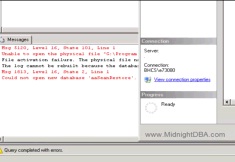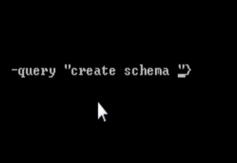This blog is part of Jen’s Un-SQL Friday collection. You can read her blog on it here.
Branding is an interesting topic to me because not many people have managed to build a more interesting brand or reputation than I have. I’ve been called on a couple occasions ‘the Howard Stern of SQL’, and while I’ve never had a naked girl in my studio, I think I have been somewhat of a shock jock. When I hit the DB world through my very outspoken InfoWorld blog I upset a lot of vendors. Not many people (and nobody in the SQL Server world) had ever talked to them the way I did, nor did they ever take the candid approach to reviewing their products that I did. Throughout the years I’ve continued to be really open about my opinions and my feelings towards vendors, products, company policies, industry standards, and the like. Now I’ve got the MidnightDBA brand and despite it being an excellent moniker, it begs the question whether being so outspoken is the best way to market a brand with such potential.
The argument of course is how much does being that way limit your audience? And can you really differentiate yourself from others without doing something to be different? There are two real reasons I’ve constructed my brand the way I have. The first is that I’ve just really never learned social niceties so I have no self-control. The second is that I’ve always found the bulk of the industry’s writings to be too vanilla and sanitized, lacking any real interesting perspective. So what has my reputation gotten me? Well I really think I’ve done alright for myself. I’ve continued to climb my professional ladder and I’ve made a really solid brand that people are really starting to like. Have I been held back at all by my approach though? Oh, that’s really kinda hard to say. The only measurable penalty I’ve suffered is that I’m not allowed to speak at PASS. Other than that though, I’ve ruffled a few feathers with others in the industry but that’s about it.
It was suggested to me a while back that being the way I am makes my audience much smaller. I’m splitting my potential because there’s a good portion of the audience who won’t follow me because they don’t appreciate my style. Yeah, I suppose that might be true, but I’ve given this a lot of thought, and I like doing things the way I do them. I like calling vendors to the mat. Frankly, I’m sick to death of reading reviews of crappy software where they just talk about how nice the colors are and how well it installs. Many of these are products I’ve used and they’re complete crap. I’m the lead DBA in a very large enterprise and I have real enterprise concerns, so when a vendor tells me their product is an enterprise-level tool I expect it to be. And I don’t care to mince words when reporting on it because I always figured other DBAs want to know what the real scoop is. Anybody can write about the positive aspects of a product, but nobody has the guts in this industry to tell you what you really need to know. So yeah, while I may split my audience by being so outspoken, the audience I do have is loyal and full of really cool people that I’m proud to call my friends. People like Denny Cherry, SQLChicken, Mark Souza, Allen White, Buck Woody, Dan Jones, Paul Randal (and Kim of course), Wendy Pastrick, Steve Jones, Brian Knight (and Devin), Grant Fritchey, Adam Machanic, and the late Ken Henderson are people I’m proud to call my friends. There are many more and sorry I can’t just sit here and name everyone, but you know who you are. You’re the friends of not only the MidnightDBA brand, but of me personally. So while I may have alienated a certain population of the SQL community, it may be best for both of us if we just leave it as it is. Because compromising myself just to pick up a few extra followers or to be able to speak at a single conference will not only disappoint me, but ultimately it’ll disappoint the fans because not being yourself isn’t sustainable.
Besides guys, don’t take yourself so seriously. Let’s lighten up and have some fun with DBs. It’s a stuffy enough topic as it is without us making it worse. And I don’t know really what it is about me that gives me such a reputation. There are speakers out there who say far worse things on stage at conferences than I ever have (or would), and nobody thinks the worse of them. I’ve heard very prominent speakers make some pretty racy sexual jokes, as well as some really borderline racist jokes. Yet they keep getting invited back to speak at the same conferences year after year. Whereas I separate my blogging life from my speaking life and I know there’s a difference between what I can say on my blog and what I can say on a stage. Just like there’s a difference between what I can say on my personal blog and what I can say on my NetworkWorld blog, or in an official magazine review. So it’s not like I don’t know the difference between the different outlets, but for some reason people act like I don’t.
To tell the truth I had really planned to cover the topic of whether you should brand yourself under your name or under some clever moniker like MidnightDBA or SQLChicken, but I got sidetracked and now this is just getting too long. So maybe someone else will cover it instead.
And what all this boils down to is you should really just be yourself. You are what makes your brand, and that’s why it’s *your* brand. Nobody else can step in and be the MidnightDBA. So whatever you choose to do, just realize that you’ll never please everyone. If I were to sanitize my writing, then I would lose the audience I have now because that’s not what they want to see. My writing wouldn’t be interesting and my webshow would be a flop. Sure, I would gain the other half of the industry I don’t have now, but at what cost? At the cost of my self-respect. And not being myself wouldn’t be fun for me so I wouldn’t write as much. So be yourself. People will either follow you or they won’t, but at least you’ll know the ones who do are yours to keep.
 What do you do if you have a set of data and log files you can’t attach because the log is damaged? Here I show you a way to attach it, fix it, and get going again. Paul Randall also discussed this in his blog here: Hack-attack a damaged DB
What do you do if you have a set of data and log files you can’t attach because the log is damaged? Here I show you a way to attach it, fix it, and get going again. Paul Randall also discussed this in his blog here: Hack-attack a damaged DB

